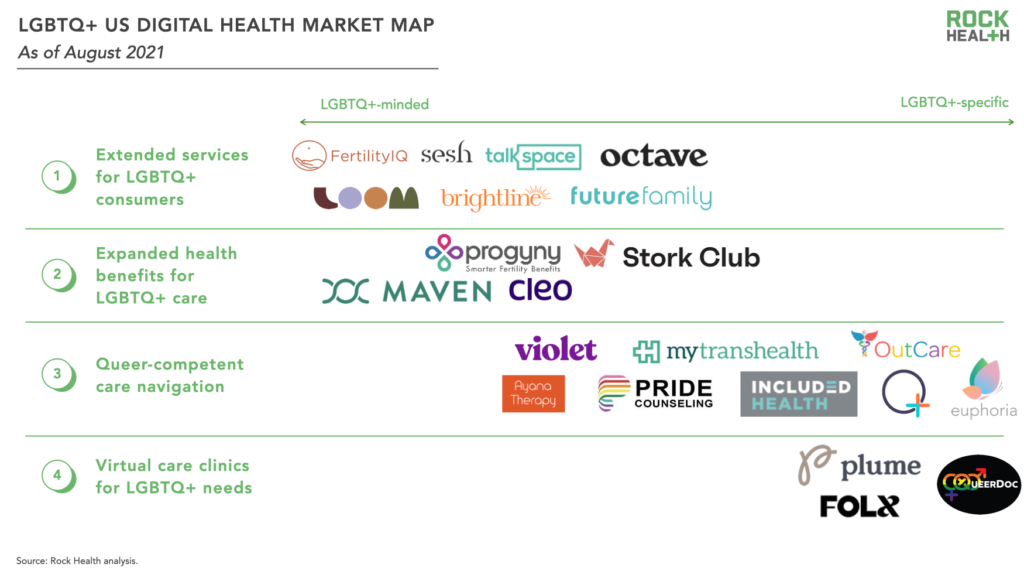Enabling more inclusive healthcare: Four market approaches to LGBTQ+ digital health
Our identities affect, inform, and define the ways that we experience all parts of our lives—including our relationships with healthcare. Even with increasing national visibility1, LGBTQ+2 Americans continue to face more discrimination in health settings and lower-quality healthcare compared to non-LGBTQ+ Americans. In a national survey, 12% of LGBTQ+ respondents reported having to teach their providers about their identities and needs in order to get adequate treatment. In another report, eight percent of lesbian, gay, and bisexual respondents and 29% of transgender respondents said that a clinician refused to see them in the past year because of their sexual orientation or gender identity.
Digital health alone won’t solve for the care gap that LGBTQ+ individuals face, but it can help to work toward a more inclusive healthcare experience. At Rock Health, we’re tracking a number of existing digital health companies, such as BetterHelp (owned by Teladoc Health), Progyny, and Grand Rounds Health, that are expanding their product and service offerings to address LGBTQ+ individuals; we refer to this category of companies as “LGBTQ+-minded.” We’re also seeing the emergence of new digital health startups that focus on delivering “LGBTQ+-specific” care and services.3 2021 is already the largest funding year to date for LGBTQ+-specific companies, driven by startups Folx Health (raising $25M) and Plume ($14M).
In this post, we’ll discuss how digital health can be an especially powerful tool for the LGBTQ+ community, review different approaches that digital health startups are taking to support LGBTQ+ individuals, and highlight opportunities for queer-competent care moving forward.
“All of us want, and deserve, to bring our full selves into our healthcare journeys; we shouldn’t have to to prioritize one of our identities over others.”
— Gaurang Choksi (he/him), CEO and Founder, Violet
LGBTQ+ Health Experiences and The Role of Digital Health
We can’t cover the full expanse of the LGBTQ+ care gap in this blog post, but we can share how deeply struck we were by the sheer amount of violence that LGBTQ+ people experience in healthcare settings. The data is troubling: 20% of trans individuals reported experiencing physical abuse from clinicians during in-person medical appointments, and eight percent of LGBTQ+ people said they’ve experienced harsh or abusive language from a provider.
Overwhelmed by these experiences and other challenges, LGBTQ+ individuals can feel forced to hide their sexual and/or gender identities (and therefore their true health needs) from providers, or to forgo care altogether. Rock Health’s 2020 Consumer Adoption Report4 found that during the COVID-19 pandemic, 53% of LGBTQ+ respondents delayed or avoided medical care compared to 41% of non-LGBTQ+-identifying respondents.
Delaying care and not disclosing health needs can worsen health disparities that already exist within the LGBTQ+ community. LGBTQ+ people face higher risks for cardiovascular disease, diabetes, mental health and substance use disorders, among other conditions. Researchers argue that these health disparities are related, in part, to everyday bias and discrimination that LGBTQ+ people experience, which affects their stress levels as well as access to care, medication, food, and safe jobs and homes.
One of the ways digital health can support LGBTQ+ individuals is by connecting them to providers who are respectful and considerate of their identity and health needs. At the most basic level, virtual care offers LGBTQ+ individuals more physical and social safety, because it allows them to access care outside of a possibly unwelcoming provider’s office. Digital health offerings can also connect people with clinicians who have been trained to deliver queer-competent and specialized care.
“Our healthcare system already makes it challenging to find a provider that you like and trust. But the experience is exponentially harder if you’re a member of an underserved group like the LGBTQ+ community. Digital health companies can fill the void by enabling patients to connect with providers who accept you for your true self while providing the care you need.”
— Chipper Stotz (he/him), Director of Care Strategy, Brightline
Rock Health data suggest that telemedicine5 adoption is already higher among the LGBTQ+ population. In our 2020 Consumer Adoption Report, 79% of LGBTQ+ respondents reported previously accessing telemedicine compared to 69% of non-LGBTQ+ respondents. Also, 61% of LGBTQ+ respondents who used live-video telemedicine in 2020 reported being more satisfied with the experience compared to in-person interactions, versus 52% of non-LGBTQ+-identifying adults who used live-video telemedicine.
“The ability to access telemedicine can be lifesaving for LGBTQ youth. Across our crisis services, we’ve found that the majority of LGBTQ youth prefer to access help via text and web chat rather than by phone call. One reason for this is that youth might assume a lower risk for misgendering or other forms of discrimination via digital platforms than one might face over the phone.”
— Amit Paley (he/him), CEO and Executive Director, The Trevor Project
Four Market Approaches to Addressing the LGBTQ+ Care Gap
In part to address the LGBTQ+ care gap, existing companies and new startups alike are entering the LGBTQ+ digital health marketplace. Established players BetterHelp, Progyny, Maven, and Future Family are expanding their product and service offerings to better address the needs of LGBTQ+ individuals (what we refer to as “LGBTQ+-minded” companies).
2020 and H1 2021 also included funding for LGBTQ+-specific digital health companies whose offerings primarily target LGBTQ+ individuals, such as Included Health, Folx Health, and Plume. In 2020, funding for LGBTQ+-specific players was $9.6M; already in H1 2021, these startups have raised $39.0M.6 Aligning with the newness of this category, funding for LGBTQ+-specific startups has been limited to Seed and Series A rounds.
Currently, Rock Health is tracking 22 US-based digital health companies developing products and services for LGBTQ+ individuals. These companies generally focus on one of four main market approaches, as outlined in the graphic below.

- Extended Services for LGBTQ+ Consumers
Digital health companies are evolving their current products and tools to provide more direct support to LGBTQ+ consumers. In the mental health space, teletherapy provider Octave staffs a team of queer-competent therapists, child and family behavioral health solution Brightline7 has clinical modules for families of LGBTQ+ youth, and virtual mental health leaders Talkspace (individual therapy) and Sesh (group sessions) offer specialized support channels for LGBTQ+ clients. Sexual and reproductive health learning portal Loom offers its own cohort of LGBTQ+ classes. Fertility finance startup Future Family provides a reciprocal IVF funding tool for lesbian and trans couples, and fertility educator Fertility IQ hosts a series of courses for LGBTQ+ audiences.
- Expanded Health Benefits for LGBTQ+ Care
Typically, opposite sex families access health benefits like fertility care by meeting exclusionary criteria (such as the medical definition of infertility); however, LGBTQ+ people don’t always fit squarely into these paradigms. Virtual benefits managers are expanding coverage to encompass LGBTQ+ family building and health needs. Stork Club (which raised a $30M Series A in June) partners with regional fertility banks to address LGBTQ+ conception needs, while virtual employee health portal Maven Clinic has unique features for LGBTQ+ families and single parents. Benefits administrator Progyny covers assistive reproductive services for same-sex couples and has a virtual content series on LGBTQ+ family building. Finally, Cleo, a parental coaching and benefits platform, enables LGBTQ+ individuals to self-identify and then matches them with coaches trained to address LGBTQ+ family needs. - Queer-Competent Care Navigation
Inclusive care can mean life or death for patients: research shows that trans individuals who receive care from a queer-competent provider are less likely to experience suicidal thoughts or desires. Digital navigation and matching platforms are helping connect LGBTQ+ people to trained, compassionate professionals and specialized care resources. Ayana, a California online mental health center for marginalized communities, matches LGBTQ+ clients to counselors trained in intersectional care. Similarly, teletherapy platform BetterHelp operates a platform called Pride Counseling, which connects clients with queer-competent virtual therapists using detailed matching algorithms.Beyond mental health, online provider databases such as MyTransHealth help patients find care from queer-competent providers in all fields, while companies like Violet, Outcare Health, and Queerly Health list inclusive clinicians and also provide professional training and credentialling. Care navigation company Included Health employs a team of coordinators that match LGBTQ+ members to clinicians, book appointments, and help sort out benefits coverage. Euphoria.LGBTQ hosts a suite of apps that connects trans individuals to queer-competent professionals and resources throughout their transition journeys.
- Virtual Care Clinics for LGBTQ+ Needs
A final group of digital health companies are operating as virtual care clinics for LGBTQ+ needs, encompassing multiple services to help patients throughout their journeys. Plume and QueerDoc both facilitate telemedicine visits, prescription deliveries, and legal consults for LGBTQ+ adults undergoing gender affirmative processes, particularly hormone replacement therapy (HRT). Folx Health includes full-spectrum care for HRT, as well as PrEP and sexual wellness management, with plans to expand into skin and hair care.
We’re also seeing digital health players like Modern Fertility, Nurx, Curology, Flo, Poppy Seed Health, and Ovia Health use inclusive language and create content as LGBTQ+ allies. Besides making digital health a queer-friendlier place overall, these actions might also hint at future plans to roll out specialized LGBTQ+ care products or services in the future.
White Space for LGBTQ+ Digital Health Innovation
Even with growing activity in the marketplace, we’re watching six big areas of white space for meaningful LGBTQ+ digital health innovation:
- Beyond specialty care. Of the 22 LGBTQ+ digital health startups we’re tracking, eight address mental health, seven support reproductive health or family building, and four focus on gender-affirming processes. But LGBTQ+ folks need and deserve specialized support across all healthcare touchpoints, including preventative screenings, primary care, and chronic care management. In just one example, LGBT HealthLink reports that LGBTQ+ populations are at a higher risk for certain cancers, but are less likely to receive preventative cancer care.
- LGBTQ+ care across all age groups. LGBTQ+ individuals have unique health needs across their lifetimes, but they’re especially overlooked in adolescence and older age. Research on LGBTQ+ youth indicates that LGBTQ+ children are coming out at much younger ages than prior generations, and we see opportunities for startups to follow in Brightline’s footsteps and work with families who are learning how best to affirm and support LGBTQ+ family members. On the other end of the age spectrum, LGBTQ+ older adults (50+) are more likely to live alone and less likely to have children than non-LGBTQ+ older adults. We’re keeping an eye out for agingtech companies providing products and services that are inclusive of LGBTQ+ seniors’ living situations and caregiving needs.
- Queer-competent training and resources for health systems. While many LGBTQ+ digital health companies serve consumers directly, there’s room for startups to help health systems and provider networks improve their LGBTQ+ care approaches. Sixty-eight percent of LGBTQ+ individuals say it’s important for their providers to have queer-competent training and policies, but only half of primary care doctors feel prepared to deliver LGBTQ+ care. To us, this signals an appetite for companies like Violet that provide training and credentialing for queer competency. Plus, as inclusive language and best practices evolve, startups like these can help clinicians continue to make LGBTQ+ patients feel seen and respected.
- Data collection and insights on LGBTQ+ health. Because sexual orientation and gender identity were not historically asked in national health surveys or clinical trials, many of today’s healthcare best practices are derived from research that doesn’t include the LGBTQ+ population. This unrepresentative data goes on to inform screening and treatment protocols, healthcare policy, and product developments that aren’t designed to address LGBTQ+ health. While there have been developments in queer health data collection (such as Stanford’s PRIDE longitudinal cohort study), digital health platforms can help address the LGBTQ+ health data gap by designing software using LGBTQ+-representative datasets and increasing visibility of LGBTQ+ users in their data collection and analytics processes.
- LGBTQ+ health benefits beyond family building. According to a 2021 survey by Willis Towers Watson, 80% of employers plan to promote diversity, equity, and inclusion (DEI) in their benefits programs in the next three years. While LGBTQ+ family building benefits are an important start, there’s room to expand queer-competent care coverage to include services like HRT, specialized cancer screenings, inclusive therapy, and caregiving assistance. For example, The Trevor Project, a nonprofit supporting LGBTQ+ youth, covers Plume’s virtual HRT clinic as an employee health benefit. Payers that provide comprehensive LGBTQ+ care coverage can stand out to employers who want to center equity in their benefits packages, while also offsetting out-of-pocket burdens for LGBTQ+ employees.
- Applying an intersectional lens. Every LGBTQ+ person’s healthcare journey is different, and experiences are uniquely impacted by factors such as race, ethnicity, religion, disability, and language. For example, a 2021 UCLA study found that Black LGBTQ+ adults are more likely to report having clinical depression and are less likely to feel economically secure than their white LGBTQ+ counterparts. Beyond incorporating queer competency, it’s important for digital health players to focus on the intersections of gender, sexuality, race, income, and disability to provide tailored support.
“There’s very little data on LGBTQ+ health. Right now, we tend to screen, treat, and care for LGBTQ+ people using protocols that exist for the general population, but those aren’t always appropriate. More data can lead to better evidence-based LGBTQ+ care.”
— Mitchell R. Lunn, MD, MAS, FACP, FASN (he/him), Co-Director of The PRIDE Study, Stanford University School of Medicine
“It’s critical to look at health needs and experiences from an intersectional lens. For example, Black lesbian cis females have different experiences compared to white cis females. We need to redesign health reporting formats and clinical decision support to address intersectional patient communities.”
— Chris Grasso (she/her), Associate Vice President for Informatics and Data Services, The Fenway Institute
Growing Demand for Specialized Care
While the LGBTQ+ digital health marketplace is still relatively small, we believe that recent moves—like the increase in LGBTQ+-specific funding and Included Health’s acquisition just one year after launch—signal that market demand for culturally-sensitive and specialized care is growing.
Growing market demand can have big implications on quality of life for LGBTQ+ individuals. Research suggests that inclusive healthcare experiences correlate to more frequent healthcare utilization among LGBTQ+ individuals, chipping away at one of the many dimensions of the care gap. With more queer-competent digital health companies in market, we hope that fewer LGBTQ+ people are pushed to delay or avoid medical care altogether, or to hide their true needs during appointments.
“When an LGBTQ+ individual has a good healthcare experience, they survive. The trans community at large has an 81% suicidal ideation rate and a 42% suicide attempt rate. When you have someone who affirms you and supports you, you get to live.”
— Katherine Anthony, she/her, CEO and Co-Founder, Euphoria.LGBTQ
Also, by being so attuned to their consumers’ needs, queer-competent digital health companies (as well as other companies focused on overlooked patient communities) are positioned as possible targets in today’s platform wars, where big digital health players are acquiring segment-specific companies to build out specialized offerings for people who need them most. In a win-win situation, segment-specific verticals like LGBTQ+ care represent a growing market opportunity, as well as a chance to vastly improve the care experience for focused populations and needs.
At Rock Health, we expect that Included Health’s acquisition won’t be the last transaction where virtual care and navigation platforms snap up startups focused on specialized, equity-centered population care. For investors and companies interested in supporting LGBTQ+ individuals and other underserved populations, today’s digital health market is ripe for innovation and investment.
“It’s not just about changing the healthcare system to be more queer-competent. It’s also about supporting more specialized and personalized care that meets you exactly where you are. In the digital world, there should be a way to create health experiences that are both personal and scalable.”
— A.G. Breitenstein, she/they, Founder & CEO, Folx Health
If you’re interested in spending time with the Rock Health research team, please reach out.
If you’re building an equity-centered digital health company and looking for early-stage funding, our venture team would love to chat! Send us your pitch deck to explain how you’re working to improve the health of LGBTQ+ individuals.
Footnotes
1Some illuminating data we’ve read about LGBTQ+ visibility in the United States: six percent of all Americans self-identify along the LGBTQ+ spectrum, LGBTQ+ adults account for $1.1T of US purchasing power, and the US has 21% more LGBTQ+ political representatives and leaders than it did in 2019. One in six Gen Zers identifies as LGBTQ+.
2Lesbian, gay, bisexual, transgender, queer, and other non-cisgender and non-heterosexual identities.
3Rock Health defines LGBTQ+-minded startups as digital health companies that explicitly serve the LGBTQ+ community with a product or service offering, while also offering other products or services and/or serving other populations. We define LGBTQ+-specific startups as digital health companies that name the LGBTQ+ community as their core audience. Companies in both categories must also meet Rock Health’s definition of digital health. Companies that have raised less than $2M are included in our market maps and landscape analyses, but they are not included in our funding figures.
4The Rock Health 2020 Consumer Adoption Survey, which surveyed 7,980 respondents, included 820 individuals who self-identified with at least one of the following categories: gender non-conforming, non-binary, lesbian, gay, bisexual, or queer. We refer to this group as LGBTQ+ within this blog post. This survey did not explicitly ask respondents to identify as a trans identity.
5Rock Health classifies telemedicine as all technologies that enable the synchronous or asynchronous delivery of healthcare services by a healthcare provider when the patient is not in the physical presence of that provider. This includes live-video telemedicine, as well as live phone calls, video and picture messaging, email, and mobile app usage.
6 This figure includes US-based companies that have raised at least $2M+, focus on the LGBTQ+ population, and fit Rock Health’s definition of digital health.
7 Brightline is a Rock Health portfolio company.

